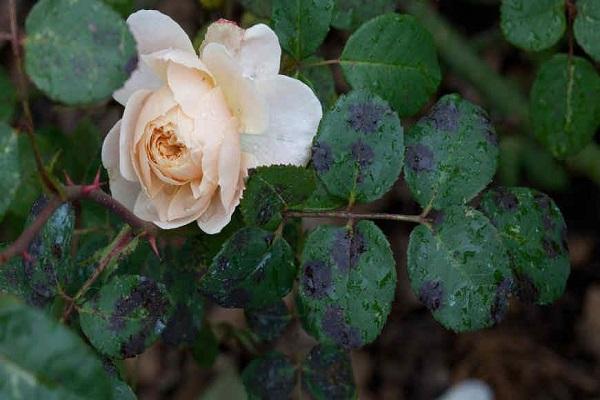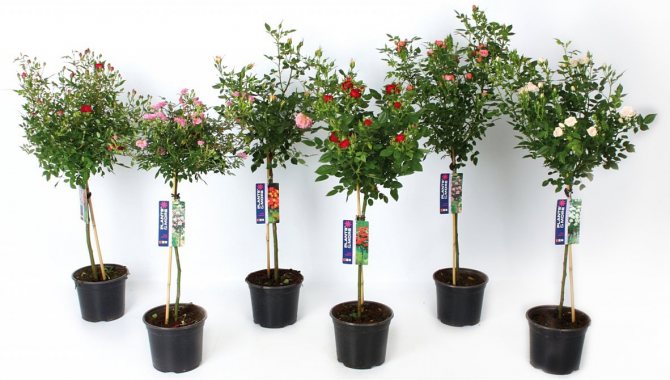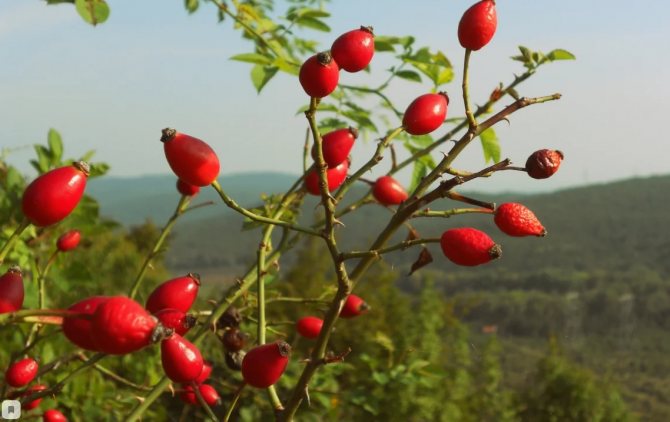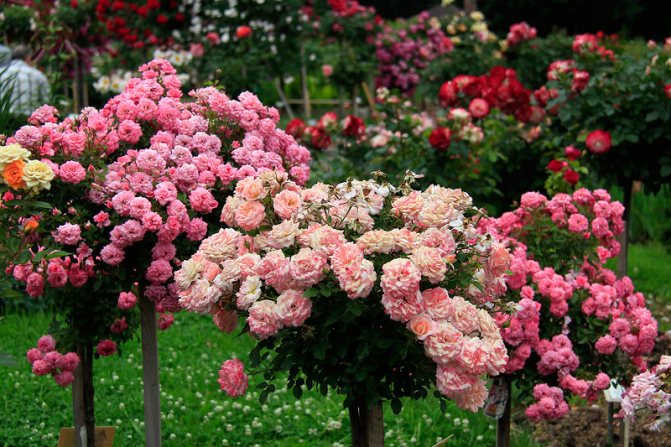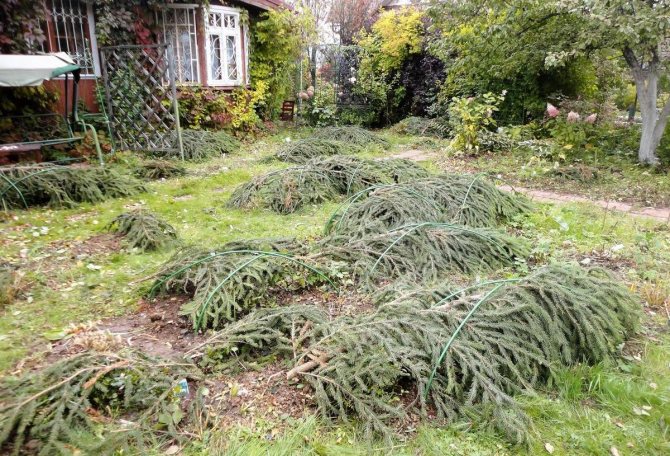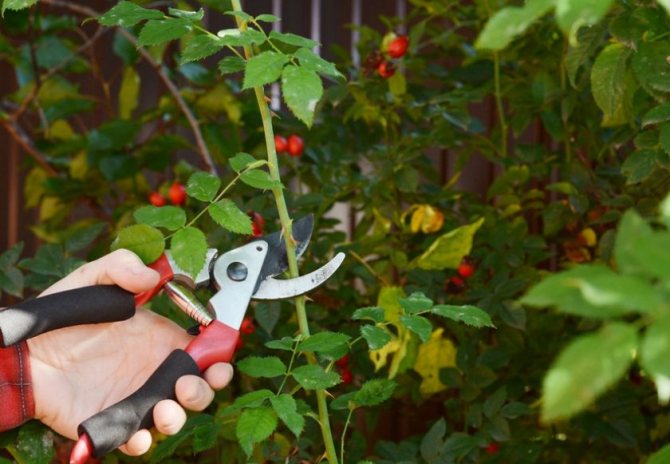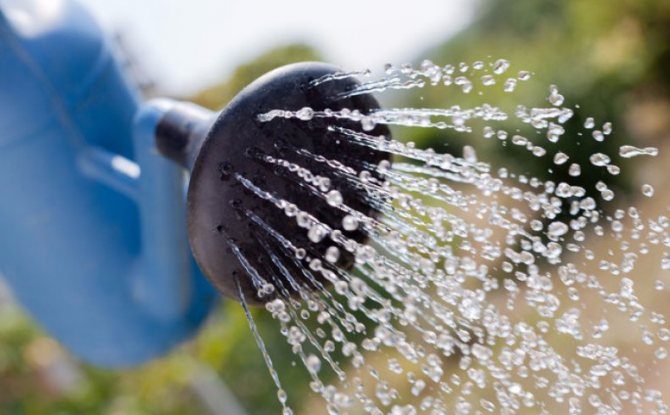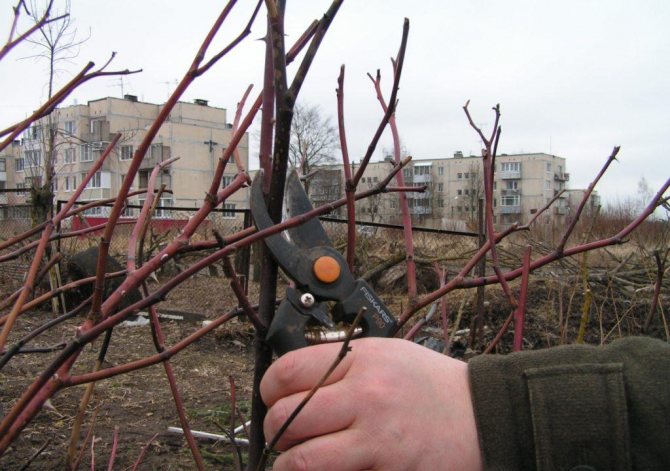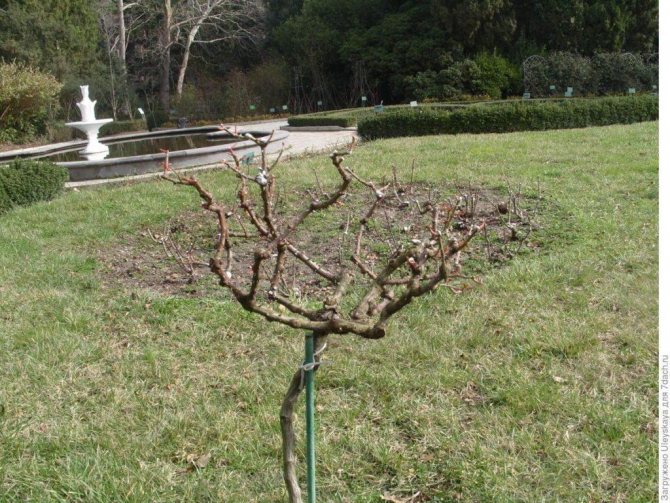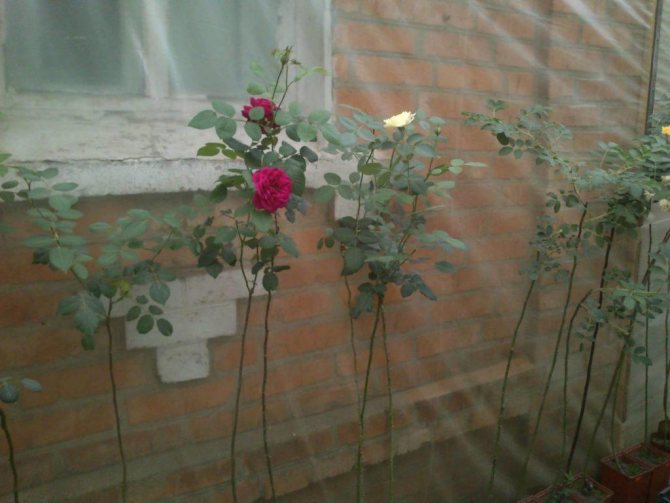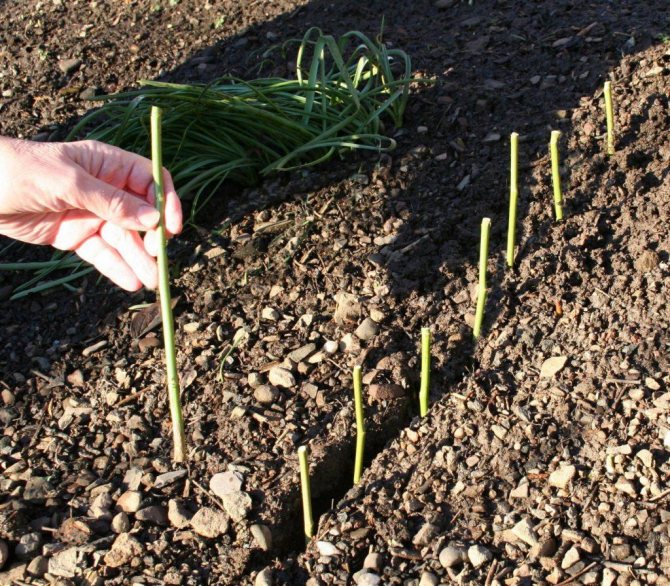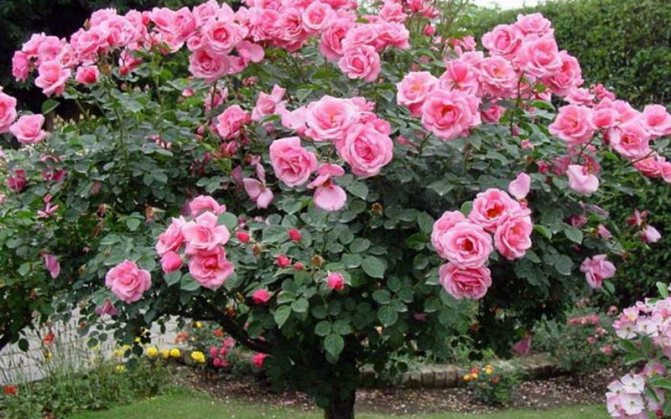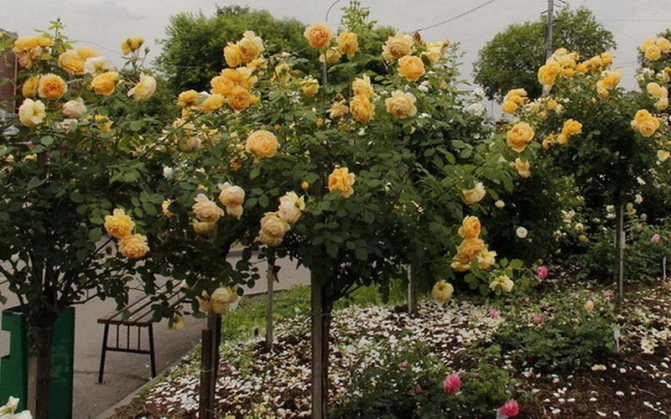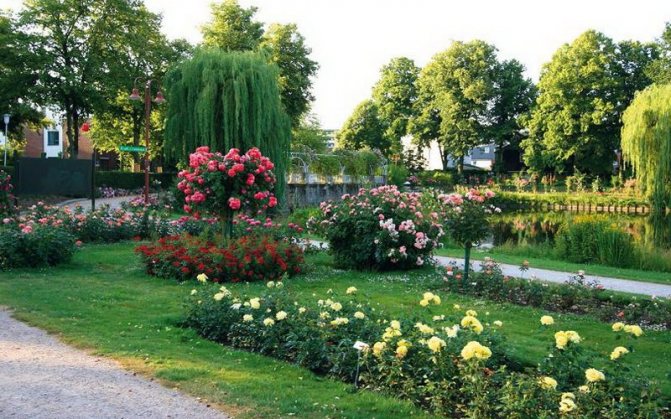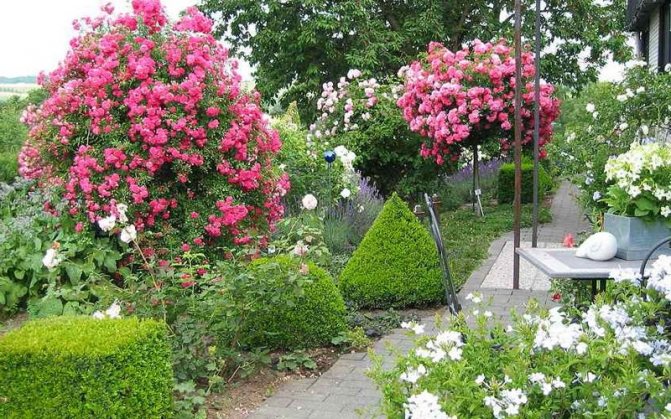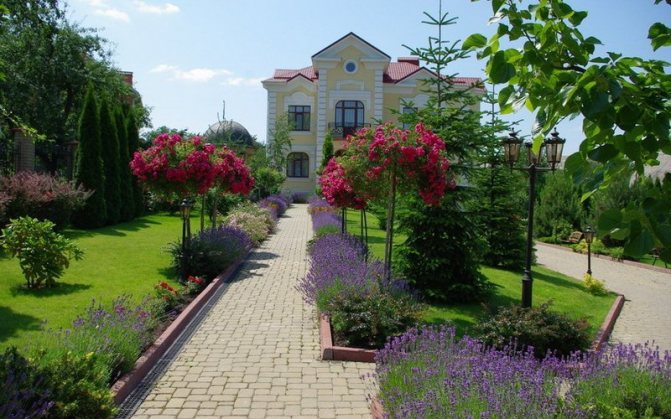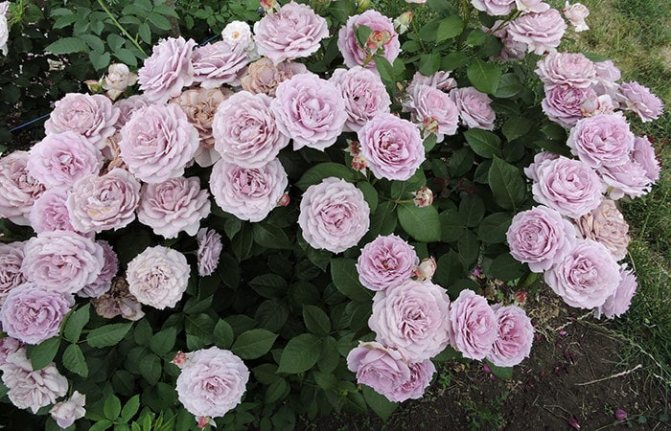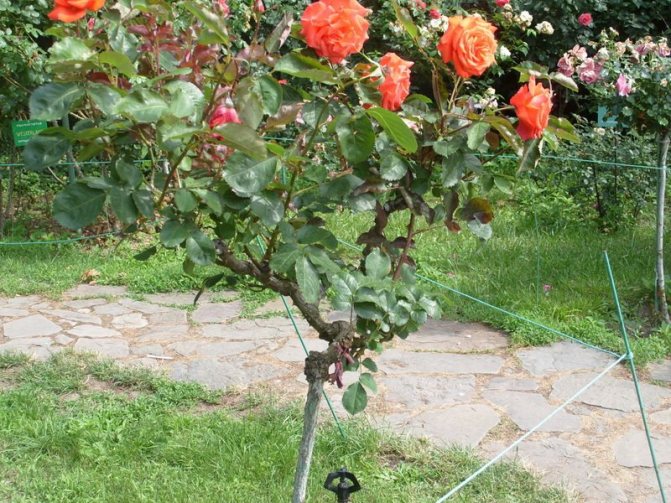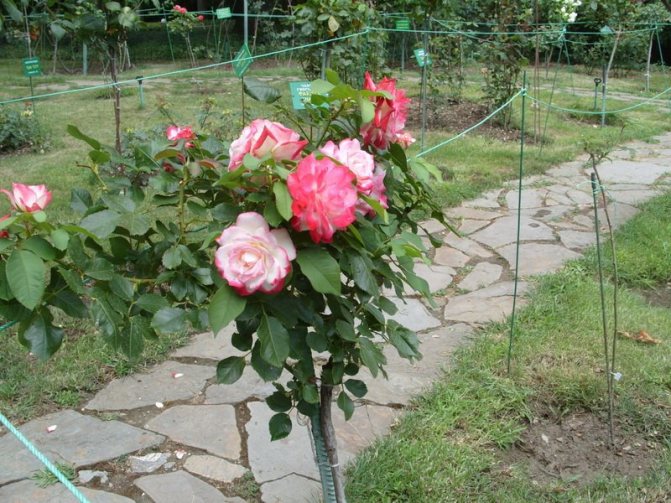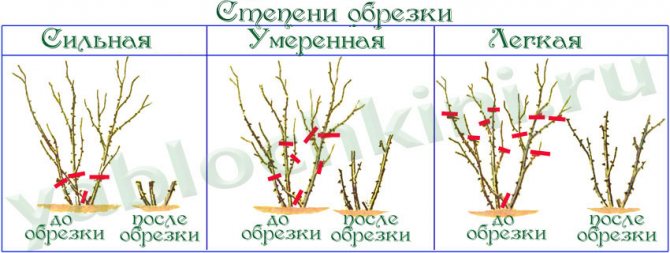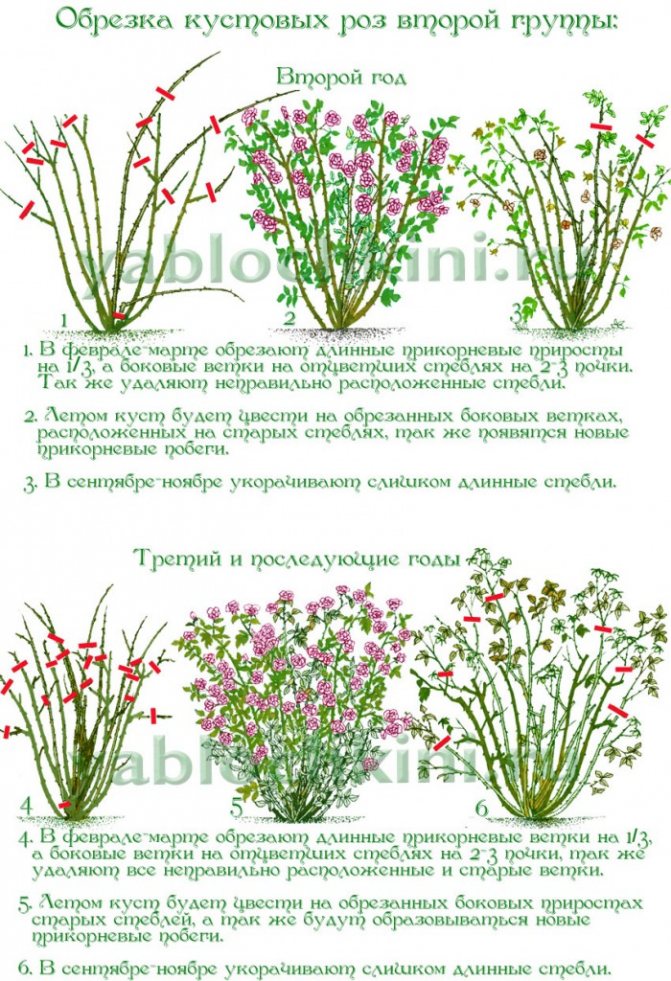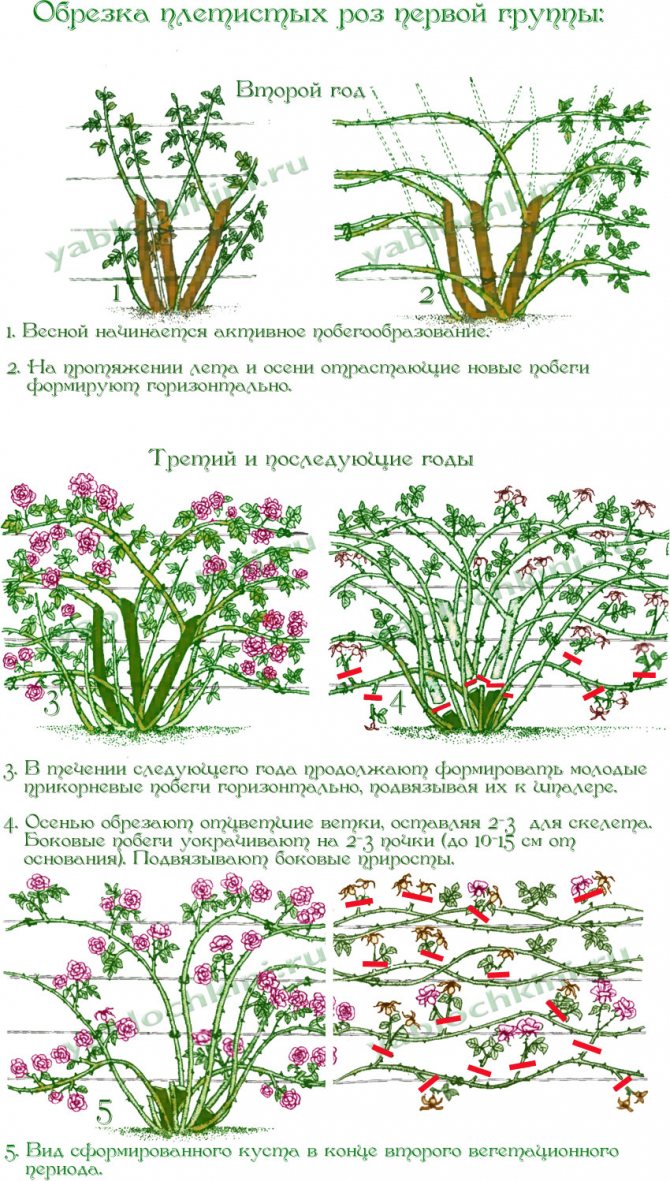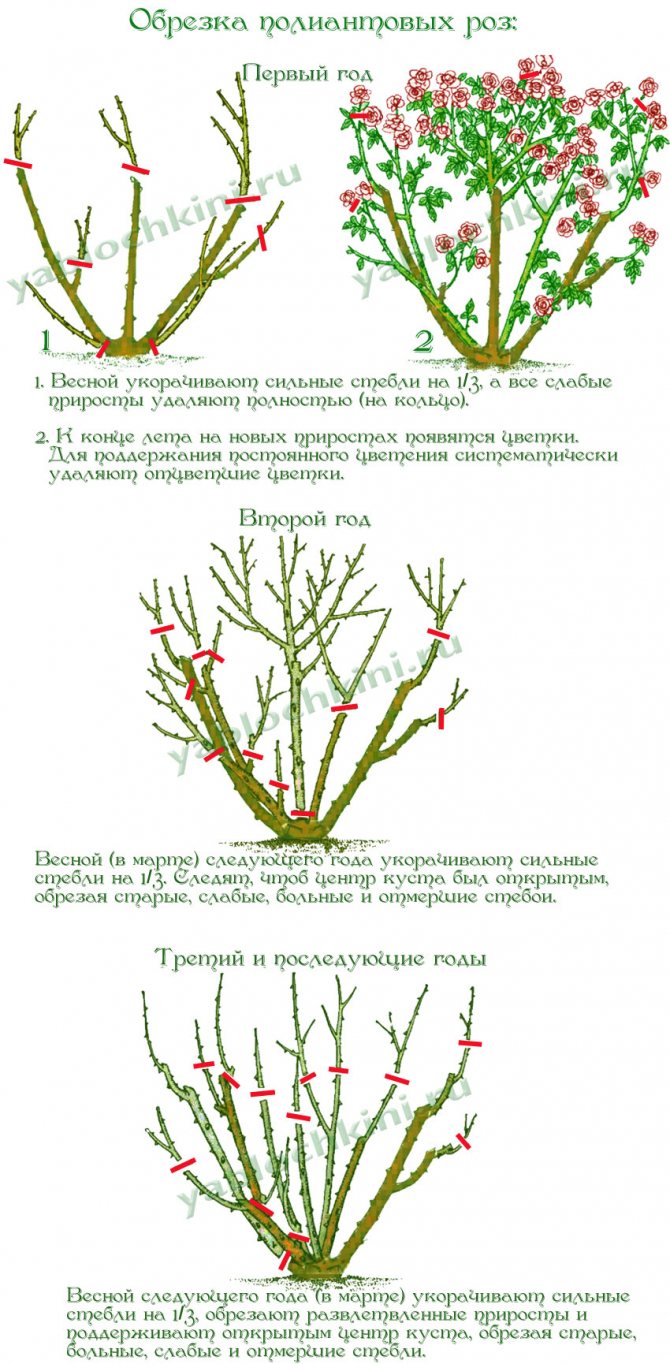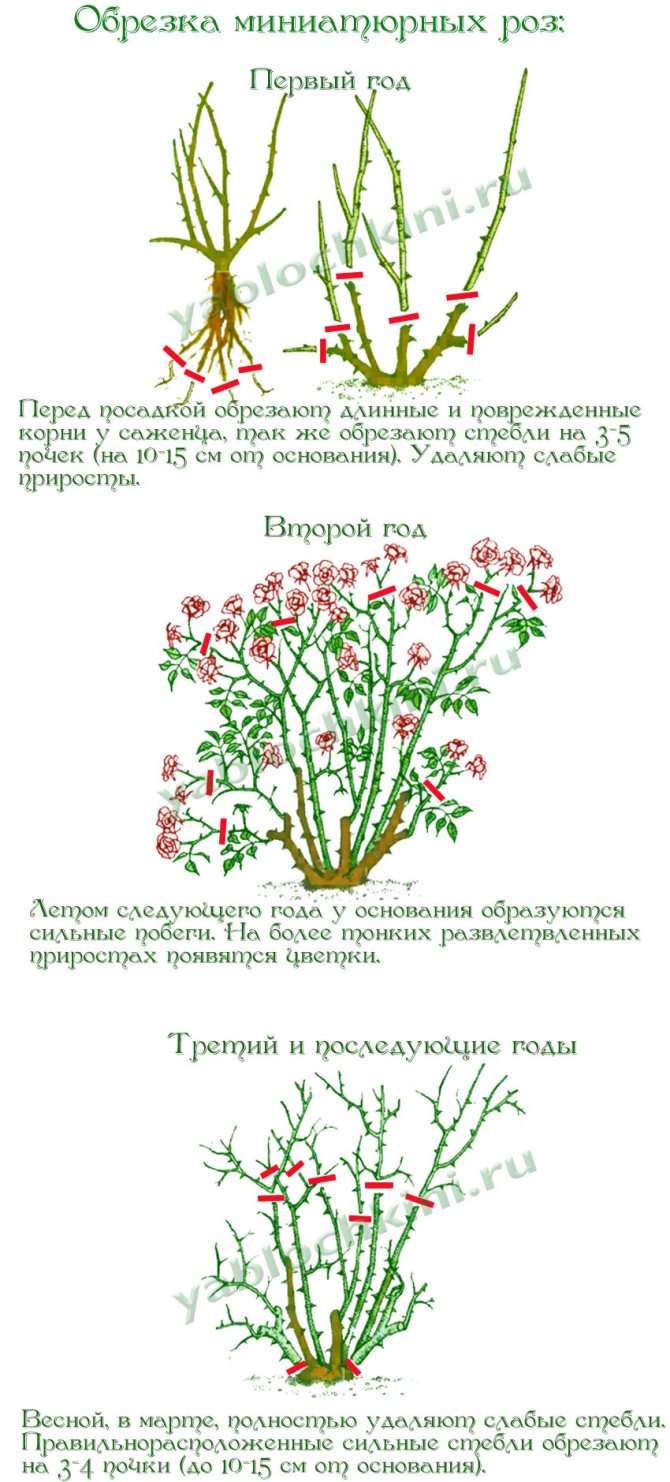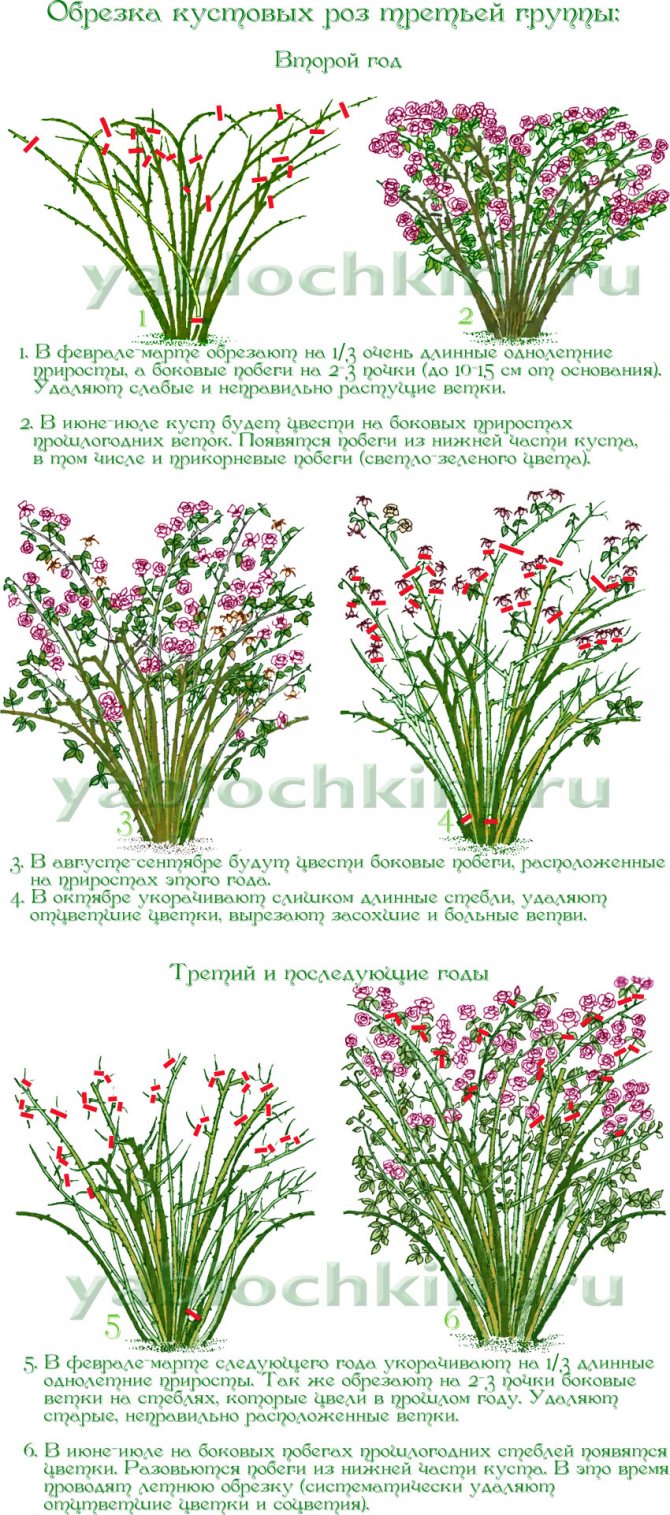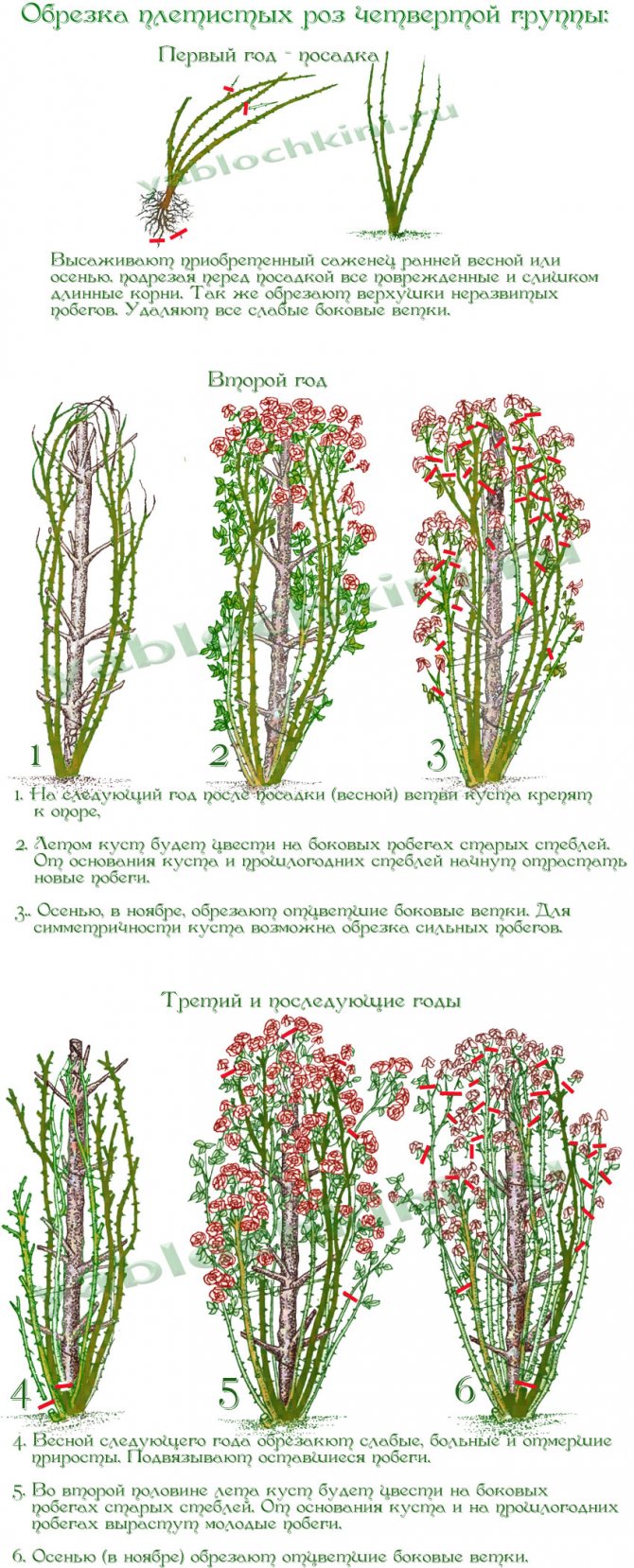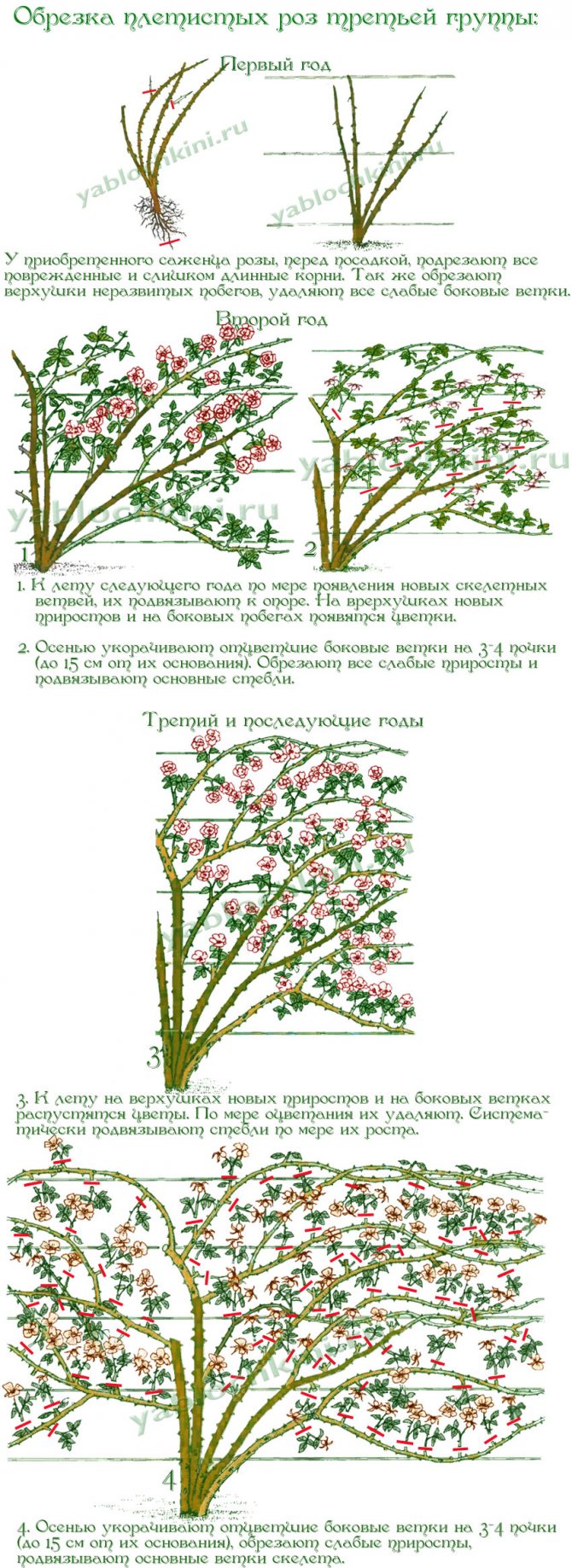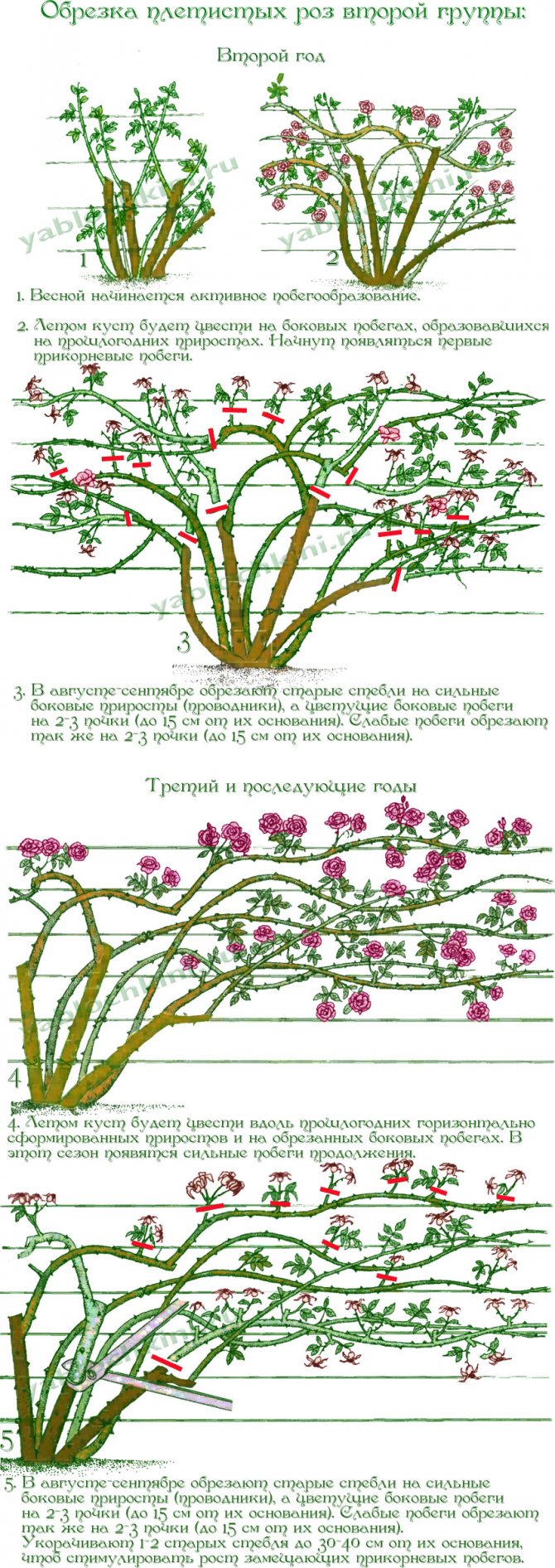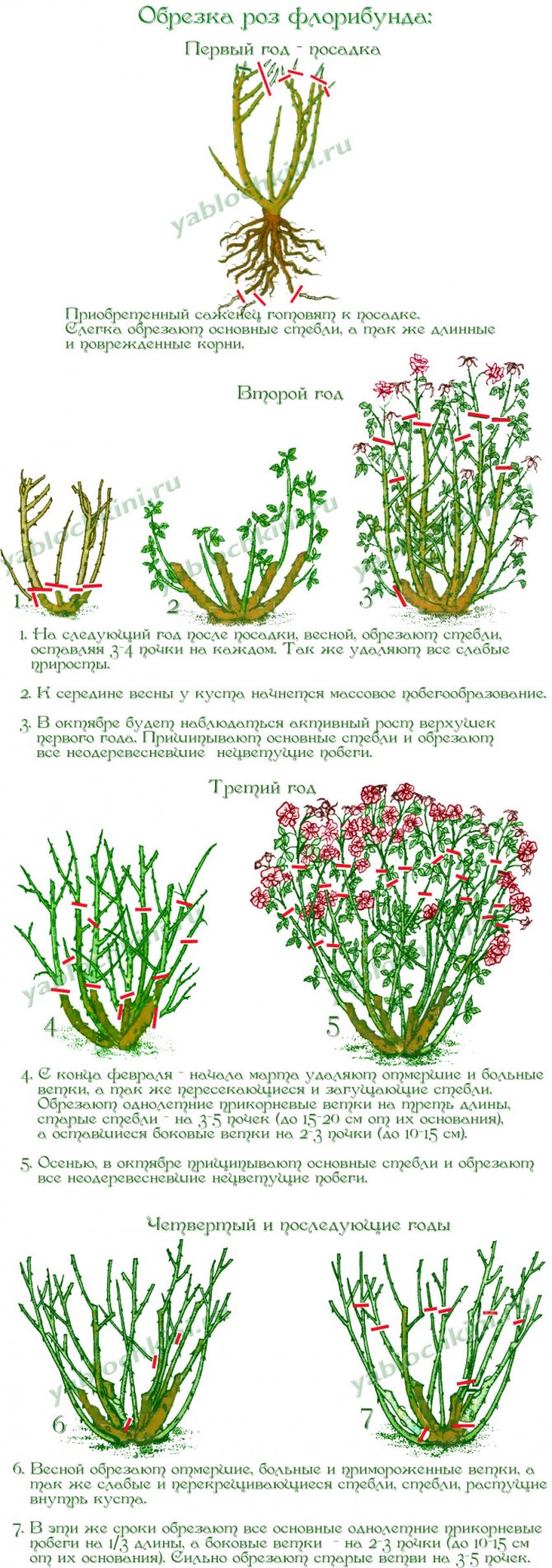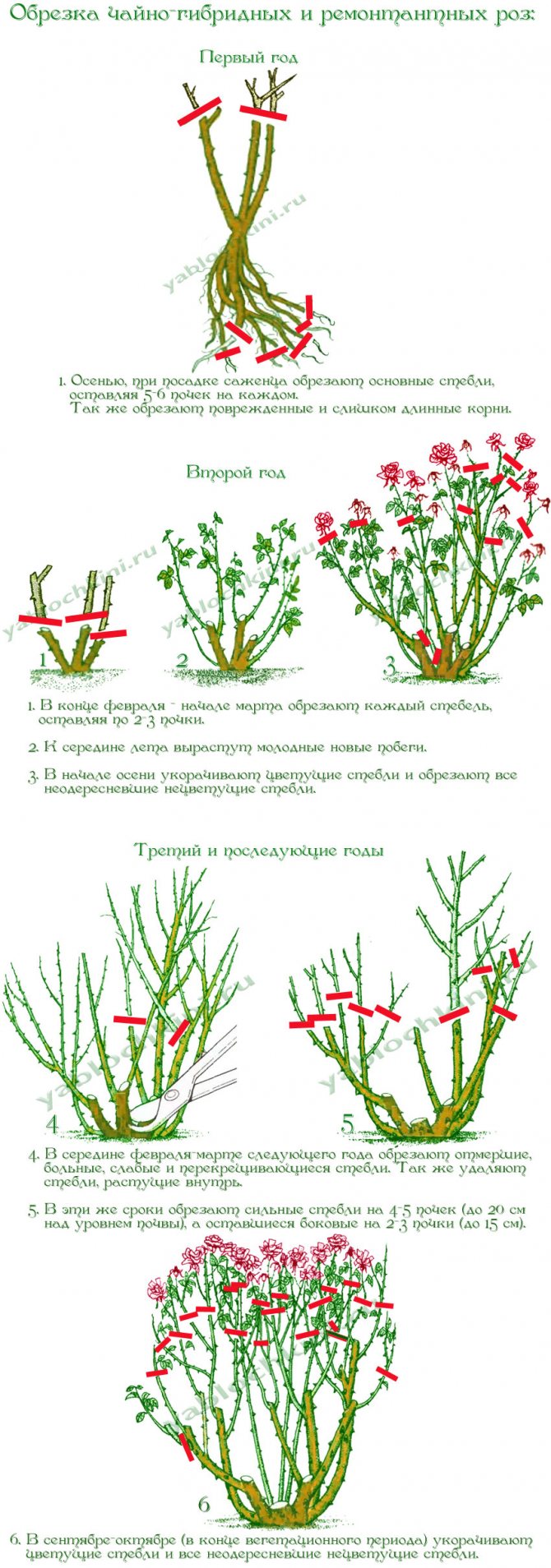Standard roses are not an independent garden group, but a garden art technique for effectively demonstrating the beauty of these luxurious flowers. A huge bouquet of roses on the trunk gives the site a unique charm, certainly becoming the center of attention. It is not surprising that today no rose garden is complete without standard roses.
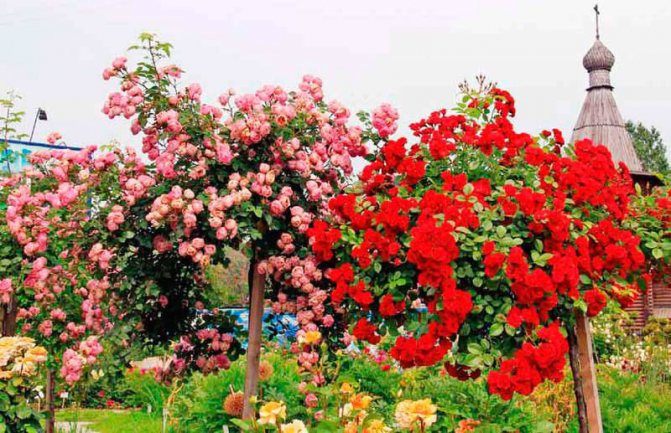
Rosewood - blooming bouquet
A standard rose is not a bush, but a tree, which should be decorative on all sides and in harmony with the overall design of the garden. The stems bloom a little earlier than spray roses and bloom for a long time and profusely. They are planted both in a single planting and in small groups. They are good in a flowerbed, along with bush roses, along paths, in a mixborder, and against the backdrop of a lawn. If they are planted together with bush roses, then the size of both is taken into account, since, for example, undersized stems can be lost in tall bushes. Shrub and standard roses of the same variety look very elegant on the same flower bed; the combination of standard roses with low bush varieties or other plants makes it possible to form the space of the flower garden very effectively (in 2-3 tiers).
Standard roses are an irreplaceable material for single plantings, and compositions from them can be supplemented with other flowering plants. If a standard rose is planted on a lawn in a single planting, it is good to plant patio roses, miniature or groundcover in its near-stem circle. Weeping standard forms make a special impression - their lashes hang down to the very ground, creating a cascade of blooming roses. They can be grown on special supports.
It is good to place traditional standard roses from hybrid tea roses and floribunda roses near benches, gazebos, paths. Small standard forms of miniature roses are very cute - they can be placed in the foreground of the site. Weeping, cascading stems are spectacular, for which small-flowered climbing and ground cover roses are used. On a spacious plot, the standard forms of shrub and climbing large-flowered roses look great.
Selection of seedlings
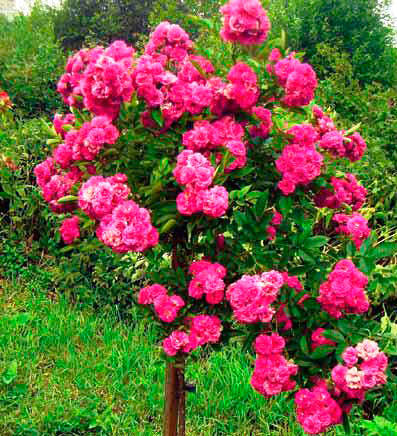

Carolyn Buddha - profusely blooming, winter-hardy
The purchase of seedlings of standard roses should be approached carefully. It is better to buy them in nurseries or specialized stores. When choosing a standard rose, it is important to find out which garden group the variety you like belongs to - further care of the plant depends on it.
An indicator of high-quality planting material is a well-branched crown with healthy lignified shoots at its base and an even stem (part of the trunk from the root collar to the grafting site - the first lower branches of the rose) and without signs of disease.
It is also necessary to find out on which type of rootstock the rose is grafted, tk. as the value of the stock in the standard culture increases. The essential qualities of the stock are good fusion with the scion and the subsequent development of varietal shoots. Unsuitable for growing boles rose rubiginoza (R. rubiginosa, R. eglanteria) and rose cinnamon (R. cinnamomea), with moderate growth, densely spiky shoots with loose wood and a lot of growth.
In Central Russia, a widespread almost ubiquitous rootstock is often used as a rootstock. rose canina (R. canina).This stock grows quickly, has good winter hardiness, a powerful branched root system, sufficient resistance to pests and diseases, a smooth and even root collar without thorns, easily lagging bark, is durable and well compatible with most varieties. Among the varieties of the canina rose, over 20 forms have been identified that are most suitable as a rootstock.
Standard roses are especially sensitive to moisture loss, so they are best purchased in containers with a closed root system. Basic requirements when choosing: the height of the container is at least 25 cm, the plant is easily removed from it, and the earthen lump is penetrated with roots. Dry or waterlogged soil, weeds or moss are signs of poor maintenance.
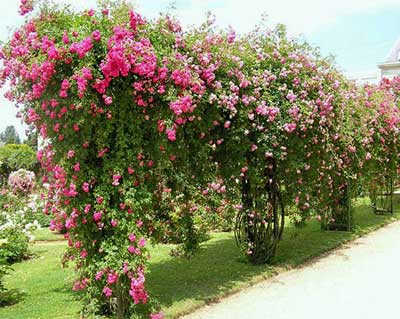

Rose: neither tree nor shrub
Each bush, tree or liana has its own crown shape. Man has learned to change the eternal appearance of plants. Back in ancient Rome, a kind of plant architecture was born - topiary. One of the first topiary works of landscape design appeared in the villa of the famous Pliny the Younger, where his name was written using sheared boxwood.
The gardens of Rome were famous for their wonderful compositions of different types of trees, bright flowers, rose gardens, powerful fountains, graceful gazebos and sculptures. And of course, topiary art. Garden owners prided themselves on evergreens that were trimmed like balls, cubes, or pyramids. Ships and bizarre figures of animals were "sculpted" from plants.
Plant plastic is multifaceted and here we will talk about a kind of topiary technique, when a shrub is given the appearance of a tree - a small trunk with a crown at the top. Plants formed in this way are usually called standard plants. Many stems are grown in pots or tubs. In the warm season, they are exhibited in the garden, and for the winter they are transferred indoors. They were in great fashion in the late 18th and 19th centuries in France and England, and are even reflected in fiction.
“At the entrance to the garden there was a large rose bush - the roses on it were white, but there were three gardeners standing nearby and diligently painting them red” - this is how one of the chapters of Alice's Adventures in Wonderland by L. Carroll, translated by N. Demurova, begins ... In the English original of the book, it says standard rose, that is, a standard rose.
In gardens, roses on a stem are still a rarity. It's a pity - they resemble graceful bouquets on a long stem. In addition, rose trees bloom profusely and for a long time, winter better and suffer less from diseases than ordinary bush trees. In other words, the advantages are obvious.
It is not so difficult to grow a standard rose
Here are some boring but helpful tips. First of all, you should take care of the rootstock for grafting a rose. A rosehip is suitable as such, but not any, but only one that is resistant to frost, pests and diseases, with a strong root system and tall, flexible shoots from the base of the bush. On three-year-old bushes, they grow up to 1.5-2 m.
Usually, a rosehip, called Rosa canina, is taken for the stock. Its fruits resemble acorns. They begin to collect them as soon as they turn brown - the seeds are already ripe, and the shell has not yet had time to harden. Gutted seeds are immediately covered with sand or peat in a ratio of one to two and stored in the basement, stirring at least once a week and moistening as needed.
Seeds are sown in October or November in moist soil. You can do this in early spring. In loose soil, they sow to a depth of 7 cm. On heavy soils, the depth is less - 2-3 cm. After the emergence of shoots, thickened crops are thinned out.
In the fall or early spring of the next year, select the strongest ones with a root collar diameter of 8-10 mm from the annual seedlings of wild rose. Dig up, shorten the roots to 15 cm, and
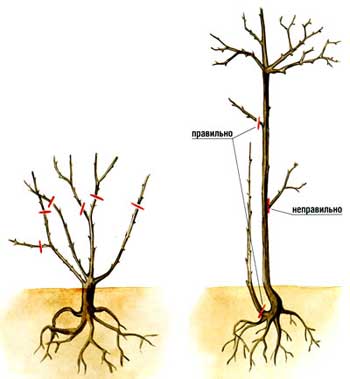

the aerial part - up to 8-10 cm and again plant it 30 cm apart and about a meter between the rows.Such a planting will help the growth of annual shoots, which then go to the stem, will become future trunks.
An annual shoot that has grown from a dormant bud at the base of the bush for 2 - 3 years is suitable for the stem. Choose the highest and straight one, cut off the rest at the root collar. If you want to acquire several standard roses of different heights, then it is useful to remember that on low boles the crown is usually formed at a height of 0.8 m, medium - 1.2 m, high - from 1.5 m.
If you have one shoot, measure its height and follow this recommendation. Take cuttings from the bushes of varietal roses you like on the eve of vaccination. To prevent the buds from drying out, wrap the cuttings in wet cloth or plastic. However, it should be borne in mind that cuttings can be stored in the refrigerator for about a month.
Rose grafting
The usual method of inoculation is the so-called budding, or kidney-eye grafting. For reliability and better development, you need to make two grafts from opposite sides of the stem, one 3-4 cm higher than the other.
The stem is usually grafted with one variety of roses, however, you can take several varieties with flowers of different colors. A week before the operation, if the weather is dry, the rosehip should be watered abundantly.
In two weeks the results will be visible. A green, swollen bud and an easily falling petiole indicate that everything is going well. If the grafted eyes have turned black, you will have to repeat everything, but already down the stem. A month later, the harness holding the grafted buds must be removed, and the shoots that have moved from them to growth must be pinned, carefully cut off with your fingers at the very top. Remove the first buds that appear. But that's not all - cut the rose hips above the graft site.
And one more tip
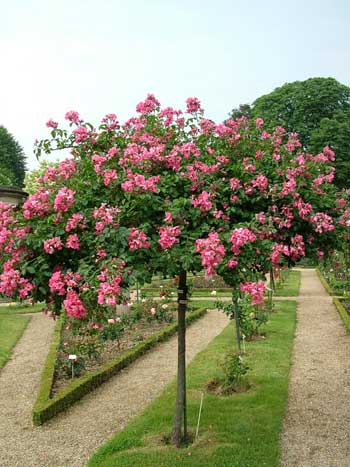

After the first frost, the plant should be carefully bent to the ground, the grafting sites should be closed from below and above with small coniferous twigs and covered with a layer of soil 15-20 cm. Check the safety of the vaccinations - what if something is wrong.
As time goes on, you follow your ward tree, a standard rose. When cultivated shoots or buds appear above 3 - 5 leaves, pinch them several times to get a branched crown, similar to the crown of a tree.
Until mid-summer, young rose plants should not be tied to a support - gusts of wind can break loose grafts that are still loose. But in the second half of the summer, support is simply necessary. Indeed, under the weight of the developed crown, plants begin to lean to the ground.
And the last thing. All summer, remove wild growth on the trunk and from the root collar. If you have the patience, you will be able to admire a young rose tree by autumn.
E. L. Rubtsova
Rose rugose rugosa
Rose curly in landscape design
Rosehip - a gift of a generous autumn
Landing
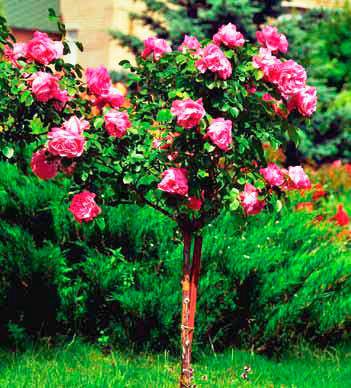

Leonardo da Vinci - floribunda
When planting, standard roses require more attention than spray roses. The site for them should be located in a sunny place and protected from the winds. The best time to plant is late April - mid-May; but throughout the summer, planting is also possible, because standard roses are sold mainly in containers.
Most grafted roses will withstand a wide variety of soil conditions as they grow on the rootstock. But light clay soils are better suited for their cultivation, which are further improved by the introduction of sand, peat compost and organic fertilizers (with small reserves of compost, it is applied during planting directly into the planting pit). The reaction of the soil should be slightly acidic (pH 5.5–6.5). It is undesirable to plant seedlings in the old place - the soil there is depleted and infected with various pests and pathogens. On such a site, remove 50–70 cm of the old soil layer and fill in a fresh one.If the soil on the site is loose and fertile, then before planting, double digging should be carried out to a depth of 70 cm so that the soil layer becomes breathable. You can grow standard roses in the winter garden or in containers on the street - for the winter they must be brought into the basement with a temperature of 1 ... 3 ° C.
When planting, you need to foresee in which direction you will have to bend the bole when sheltering for the winter. In order not to break the stem during installation, the bend at its base should be on the side opposite to the slope. First, a stake is driven into the hole with a height not less than the trunk of the trunk, then the plant is carefully lowered, trying not to bend the roots, but to place them evenly. The ground around the trunk is pressed, and then trampled down. The stem itself is tied to the stake, otherwise it may break under the weight of the crown or bend so that the development of the shoots will go obliquely, and the crown will acquire an asymmetrical shape.
Seedlings from containers are planted in pits larger than an earthen lump, and must also be tied to stakes. Unlike spray roses, which may have a slight deepening of the root collar, standard roses are planted without deepening. After planting, the standard rose is always watered, even if the soil is wet.
History of origin
Little is known about the history of the emergence of the standard rose. It is not known who exactly came up with the look, perhaps through the passage of time or a desire to remain incognito.
It is believed (according to legends) that the first who managed to breathe his creation into life was the royal gardener. The originator, unknown to us, waited until an ordinary rosehip (Rosa canina) grew and implanted a bud of a cultivated varietal rose on it. He deliberately wanted to draw the attention of the fair half to the "queen of flowers", which at that time were small bushes of various colors. His idea was a success. Indeed, the ladies of the court in their luxurious crinolines (a special rigid frame on which other layers of skirts were superimposed), in which it was difficult to bend down, could simply come closer, touch the magical flowers, enjoy their smell, or tear them off for themselves.
Such a discovery took place in the 18th or 19th century. At first, in the era of enlightenment, romanticism), standard roses were in wide demand, since they were a fashionable accessory or the pride of a garden or alley. In England they are called pedestal rose bush, not a separate variety.
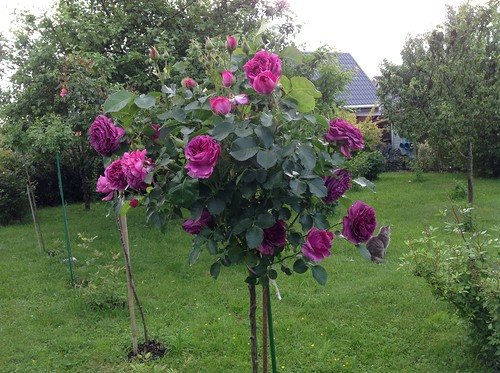

Subsequently, as often happens, the story played a cruel joke with the standard group, namely, pushed them into the background. They stopped inspiring people, rather they gave the garden sadness and loneliness. However, then they still managed to draw public attention to their person.
Nowadays, standard roses are very popular in Europe. In Russia, among a small number of the population, there is a preconceived opinion about them as not winter-hardy varieties, but this is far from the case. In Moscow and the Moscow region, you can find on sale stems grafted onto a winter-hardy rosehip in a container or in a pot. However, for reinsurance, it is worth covering them for the winter or bringing the planted plants into a pot into the house.
Care
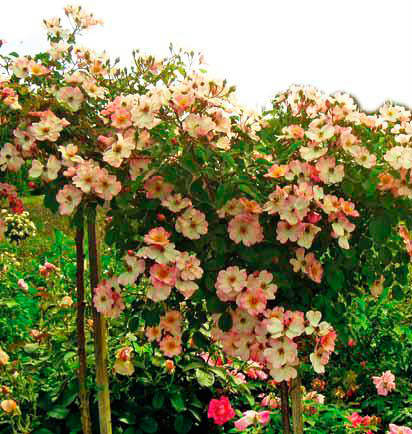

Rosie Kushn - ground cover rose
After planting, for the engraftment period, the crown of the trunk must be protected from drying out by covering it with moistened moss or cotton wool and wrapping it on top with paper. Moss (cotton wool) is periodically moistened and removed after 7-10 days; it is better to do this in the evening or cloudy weather.
Standard roses, like bush roses, need to remove wild growth and faded flowers, loosening the soil, watering, feeding, treatments against diseases and pests. In grafted plants, shoots of wild growth often appear below the grafting site and from the roots. It develops very quickly and differs from the cultivated rose in smaller foliage, prickly. If overlooked, wild growth can weaken the plant and even lead it to death.
Use in design
Standard roses are very often used in the design of a garden, flower beds, gazebos, alleys, etc. They are used to decorate the paths leading to the house, ceremonial areas where benches are attached. The stem is excellent both in a solitary plant (singly) and in a group planting of several varieties of different tones. The rose on the pedestal is extremely luxurious, it looks like a fountain or a volumetric layer, a huge withering liana.
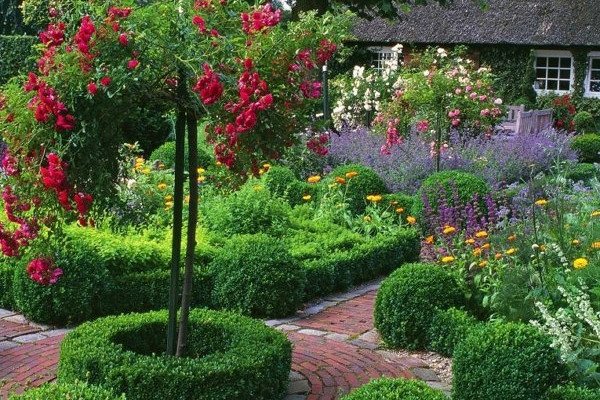

Since this species is raised above the ground, it is better ventilated and illuminated, and therefore more likely to be covered with buds. Among the total number of flowers, you will certainly highlight the stem. They can be rationally disposed of when filling an insignificant area.
All varieties of roses can grow on the stem, however, in my opinion, you should take a closer look at such types as: "Piccadilly" (yellow-red), "Moscow Morning" (pink), "Pharaoh" (red), "Nina Weibul" (light red), “Queen Elizabeth” (pink), “Lydia” (pink), “Ruby Star” (white and red), “Pink Flash” (marble or pink and white strokes), etc. A branchy or rounded crown creates a panoramic view of relaxation.
If you take proper care of the standard rose, it will delight you with its color throughout the summer.
In addition, the "rose bush", as the stem is called in England, is grown in containers, pots, which can be easily rearranged from some place or brought into the house when it gets cold. Plants such as geraniums, lavender or sage, stonecrop, low bells, from annual plants - lobelia, petunia, ageratum, heliotrope are well combined with standard trees and emphasize the greatness of such plants as: gray fescue, maned barley, etc. In general, we can say about the standard rose that it is beautiful for the embodiment of any ideas in landscape design.
On the standard rose, everything is in perfect harmony: cascading shoots, strong trunk, luxurious richness of flowers, long flowering. This type of "queens" will decorate even an insignificant area and will definitely suit your taste.
Pruning
The main purpose of pruning is to form a beautiful round crown. In this case, the spring pruning of the crown is carried out depending on the belonging of the variety to one or another garden group. Do not cut the shoots of hybrid tea roses, floribunda roses and miniature roses too short (as can be done with spray roses) - leave more than 5-6 buds. Strong pruning (when only 2-4 buds are left) promotes the formation of too powerful tall shoots that violate the shape of the crown. In climbing standard roses, the main shoots that have faded last year are cut out, leaving young replacement shoots, while shortening them a little. If there are no replacement shoots or there are few of them, then the faded shoots are not cut out, but the lateral branches are shortened on them. In cascading standard roses (ground cover), the main and side branches are shortened.
Pruning should be done with a sharp pruner 0.5 cm above a well-developed bud. The cut should be straight. Thick shoots are cut with a delimber or file. All sections over 1 cm must be covered with garden varnish.
An article about standard roses will help you choose, plant, grow, prune and prepare for winter
Standard roses are not an independent garden group, but a garden art technique for a spectacular demonstration of the beauty of these luxurious flowers. A huge bouquet of roses on the trunk gives the site a unique charm, certainly becoming the center of attention. It is not surprising that today no rose garden is complete without standard roses.
Standard rose - not a bush, but tree, which should be decorative on all sides and in harmony with the overall design of the garden. The stems bloom a little before spray roses and bloom long and profusely. They are planted both in a single planting and in small groups. They are good in a flowerbed, along with bush roses, along paths, in a mixborder, and against the background of a lawn.If they are planted together with bush roses, then the size of both is taken into account, since, for example, undersized stems can be lost in tall bushes. Shrub and standard roses of the same variety look very elegant on the same flower bed; the combination of standard roses with low bush varieties or other plants makes it possible to form the space of the flower garden very effectively (in 2-3 tiers).
Stamp roses are an irreplaceable material for single plantings, and compositions from them can be supplemented with other flowering plants. If a standard rose is planted on a lawn in a single planting, it is good to plant patio roses, miniature or groundcover in its near-stem circle. Weeping standard forms make a special impression - their lashes hang down to the very ground, creating a cascade of blooming roses. They can be grown on special supports.
Stamp roses
It is good to place traditional standard roses from hybrid tea roses and floribunda roses near benches, gazebos, paths. Small standard forms of miniature roses are very cute - they can be placed in the foreground of the site. Weeping, cascading stems are effective, for which small-flowered climbing and ground cover roses are used. On a spacious plot, the standard forms of shrub and climbing large-flowered roses look great.
Shelter for the winter
They begin to shelter standard roses in late October - early November, before the onset of stable cold weather. Pre-cut the crown in accordance with the belonging of the variety to the garden group, however, all unripe shoots are removed completely. In hybrid tea roses and floribunda roses, shoots can be shortened to a height of 30–40 cm. If the standard rose is cascading, longer shoots are left; in climbing small-flowered roses - all shoots to the full length, slightly shortening them. However, in any case, cut off all the leaves - it is undesirable to leave them, because during the winter they rot and become a source of fungal diseases.
The stem is undermined with a shovel and bent to the ground, spruce branches are placed under the crown of the stem, and another layer of spruce branches on top, securing with film or lutrasil. The root and base of the trunk are covered with dry earth (in some cases, the crown with spruce branches can also be covered with earth). In the future, the snow that has fallen completely covers the plants and serves as a warm blanket for them.
The shelter should be completely removed in the spring only after the snow melts and the danger of severe frosts has passed - usually after April 10. But later opening leads to damping off and death of plants.
The most beautiful varieties of standard roses (with photo)
The most beautiful varieties of standard roses grown in the middle lane are described below.
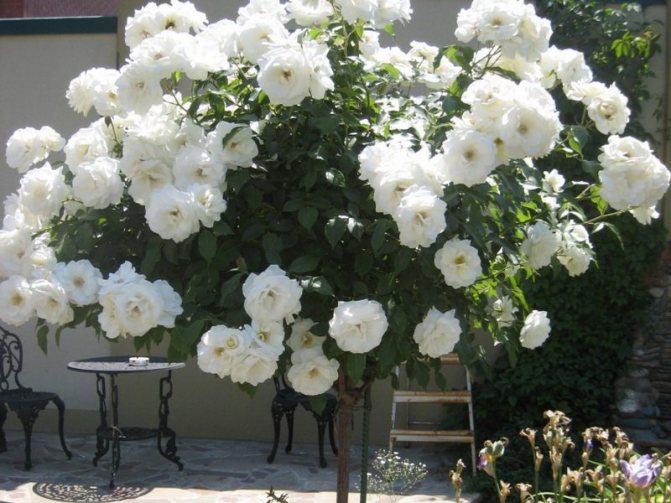

Stamp roses "Iceberg" in the photo
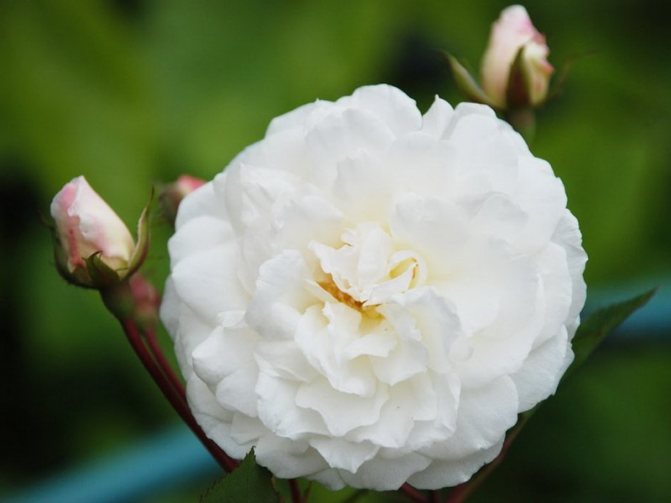

Pure white flowers, double
"Iceberg", or "Schneevitchen" - floribunda rose with pinkish buds and pure white double (30-40 petals) flowers up to 7 cm in diameter. Very abundant flowering. The leaves are green, very shiny. The bush is vigorous, up to 1 m high.
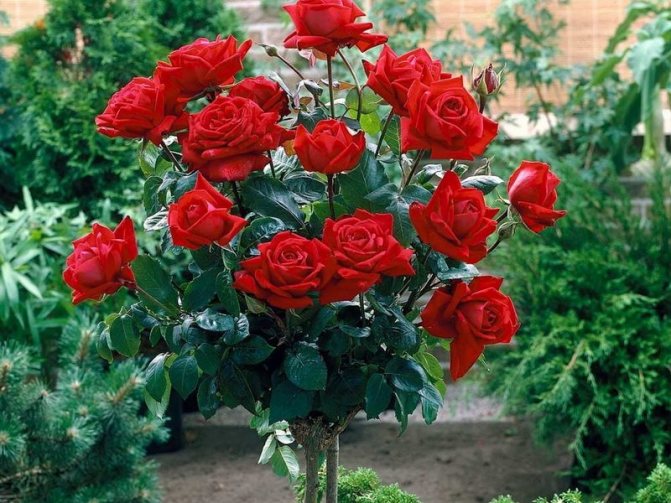

Stamp roses "Ingrid Bergman" in the photo
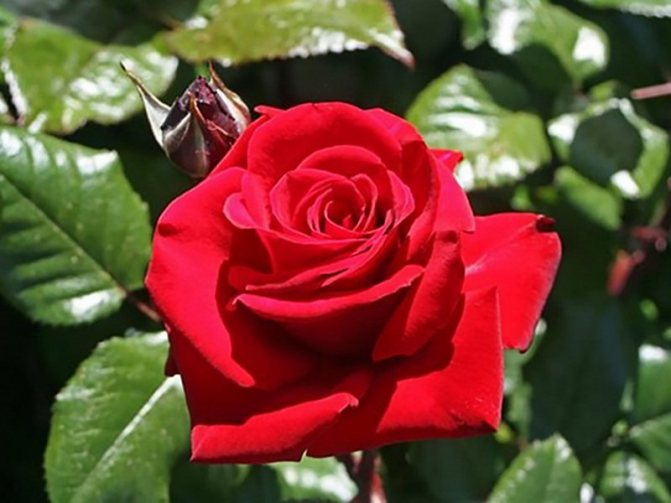

Dark red medium-sized flowers
Ingrid Bergman - hybrid tea rose with medium-sized (35 petals) dark red medium-sized flowers. In culture since 1985. The flowers are fragrant, the flowering is profuse. The leaves are dark green, highly shiny. The advantages of this one of the best varieties of roses on a stem are winter hardiness and high resistance to diseases.
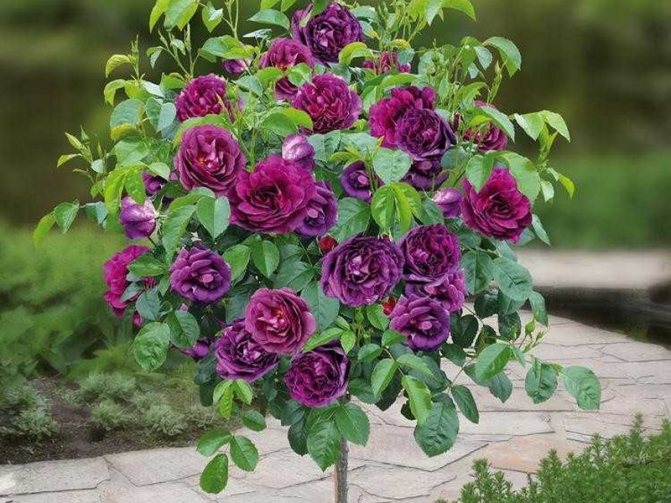

Stamp roses "Cardinal de Richelieu" in the photo
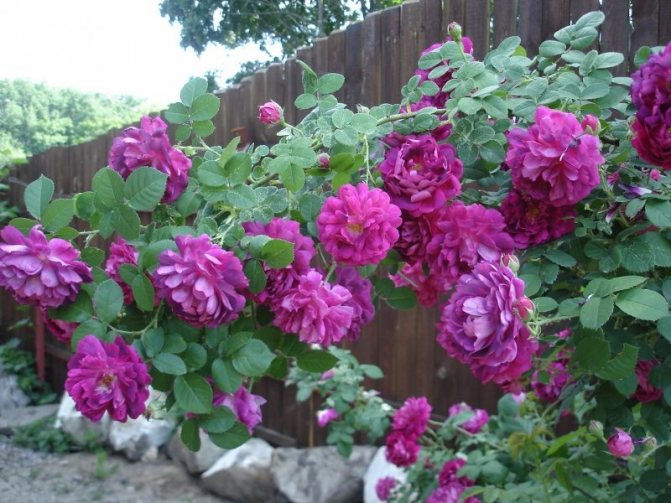

Double flowers, medium size, dark purple
"Cardinal de Richelieu" - a rose from the shrub group. The flowers are double, medium-sized, dark purple in color, fragrant, collected in a brush. Flowering continues for a month. The dark green leathery leaves are numerous, the shoots are almost without thorns. The bush is compact, up to 1.2 m high.The advantages of the variety are winter hardiness and high resistance to diseases.
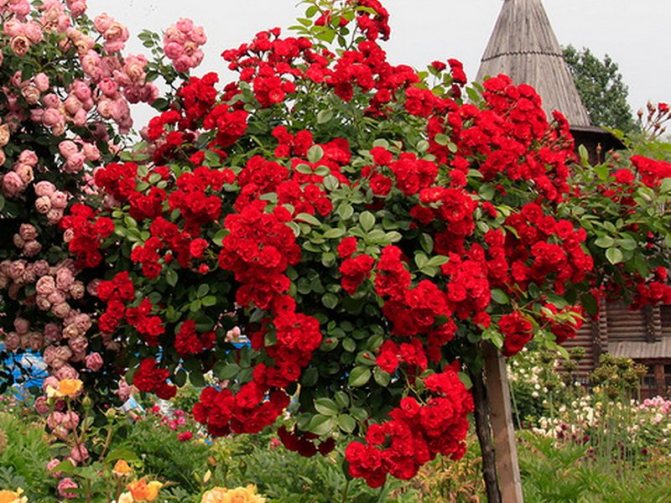

Standard roses "Lily Marlene" in the photo
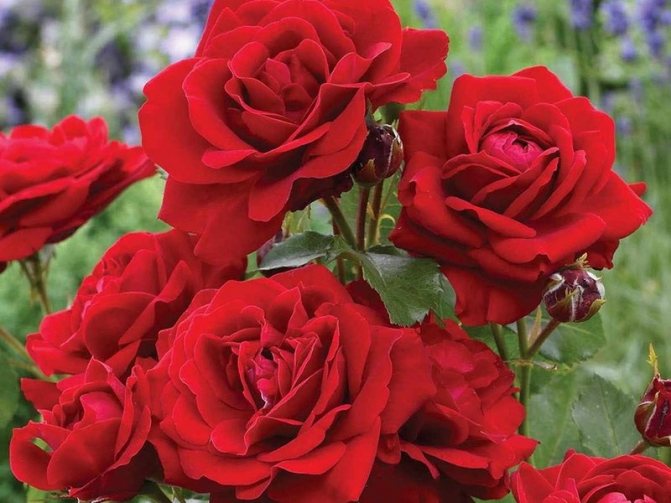

The flowers are dark red, medium-sized
"Lily Marlene" - the buds of this hybrid tea rose are almost black in color, the blossoming flowers are dark red, medium-sized, have 25 petals. The aroma is weak. The leaves are shiny, green with a bronze sheen. The bush is vigorous, up to 80 cm high. The advantages include the resistance of flowers to rain and sun, the disadvantages are weak resistance to diseases.
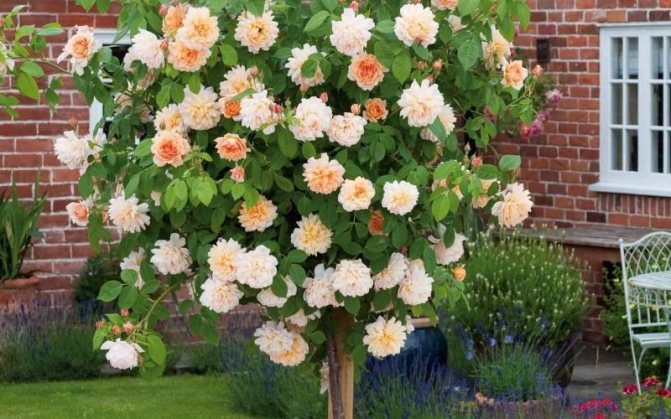

Stamp roses "Lyons-Rose" in the photo
Lyons-Rose - floribunda rose with large cupped very double flowers. The color of the petals is creamy white, with a yellow-apricot center.
Pay attention to the photo - this variety of standard roses has flowers collected in inflorescences of 3-5 pieces:
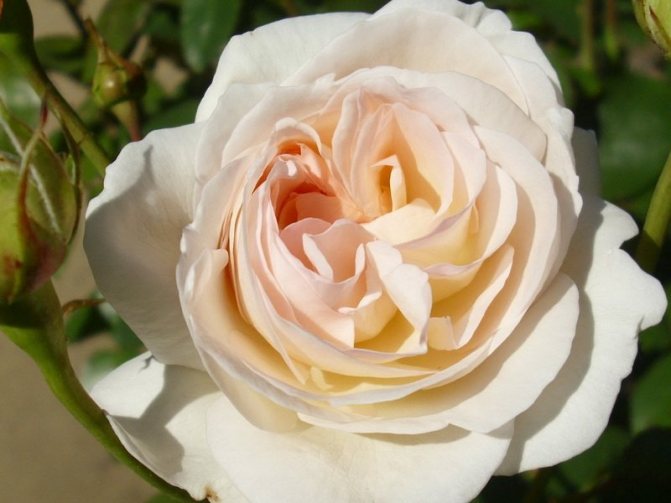

The flowering is profuse and long lasting. Has a pleasant aroma. The foliage is green, dense. The bushes are medium-sized. The dignity of the variety is high frost resistance.
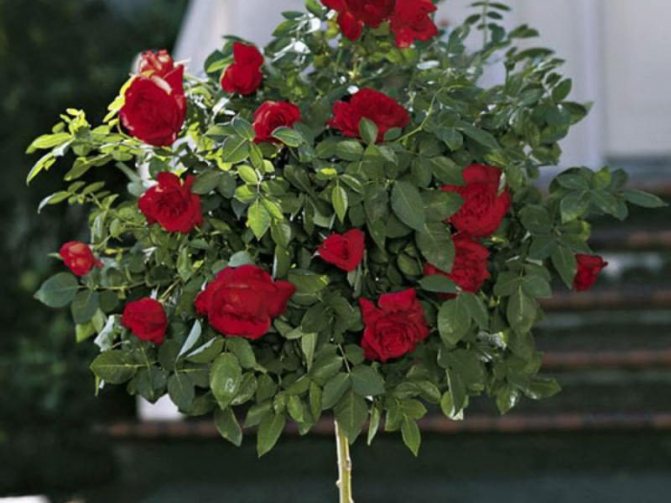

Stamp roses "Lubecker Rothspon" in the photo


Floribunda rose with wine-red goblet flowers
Lubecker Rothspon - floribunda rose with wine-red goblet-shaped flowers. Flowers are collected in large inflorescences. Blooms very profusely until frost. The leaves are dark green, shiny. The bush is up to 60 cm high, the shoots are straight.
Combination with other plants
Firstly, chic bouquets of standard roses look great against the background of the lush greenery of the lawn or the sky. Secondly, they fit perfectly into any corner of the garden and on any flower bed. It is customary to plant roses of this type next to the following flowers:
- weeping willow;
- monard;
- green undersized shrubs;
- flowering ornamental bushes.
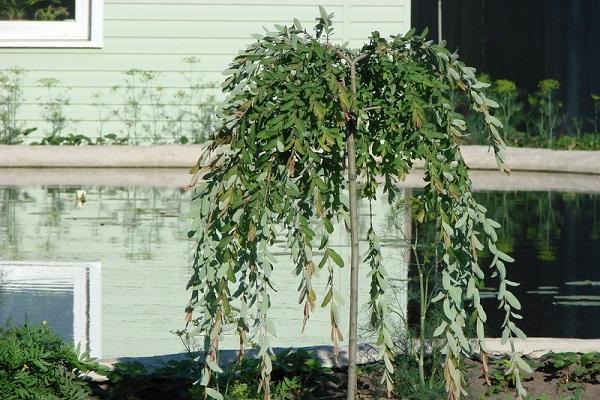

Erect flowers of smaller sizes can be planted under the crown: asters, marigolds, gladioli. You can play with the colors of the roses themselves, mixing white with orange, red with cream. This is where your imagination should work.
By purchasing and growing a standard rose, you get an unforgettable beauty that will attract any passer-by. These plants take root well in any conditions. They can be grown both in the open field and in the house - as an indoor "pet".
Self-supporting support
It is not at all difficult not only for an experienced, but also for a novice florist to make a high-quality support for a decorative culture himself. The support structure must be of sufficient height to effectively support the crown of the plant. The form and materials for the manufacture of the support must be selected depending on the landscape features of the site and the purposes of planting an ornamental culture:
- decorating garden buildings;
- creating a shady place to relax;
- planting a central element of a flower garden or garden decor;
- implementation of vertical gardening;
- creating a green hedge.
It is recommended to choose the type of support structure depending on the size of the ornamental plant. When growing a rose with a small stem, it may be sufficient to use a short steel rod. Larger stems may require special plastic supports that sink deep into the ground, but must be high enough to rise above the topmost shoots of the plant.
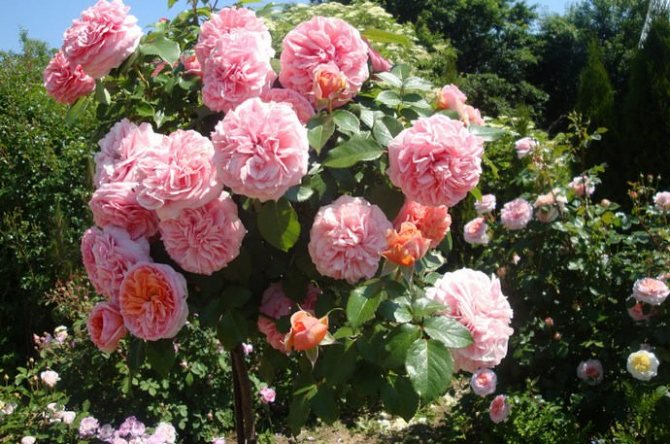

It should be remembered that wooden poles are less durable, but more affordable. Such designs fit perfectly into almost any garden decor, and also do not interfere with the full growth and development of the plant. The creation of metal support structures, especially of unusual designs, may require some welding skills. In addition, the metal cools down rather quickly at low air temperatures, which is not very favorable for plants.
As a rule, to fix the plant on the support structure, electrical tape is used, which stretches very well and is not able to injure the stem of the crop. The stem of the plant should be fixed directly under the crown and at the base of the stem, at a height of ten centimeters above the ground level.
Fertilizing
Fertilizers should be added to the soil already during the planting of the rosewood. If you want your stem to bloom for a long time and often, we advise you to add granular superphosphate to the bottom of the dug planting hole.
Other fertilizing with special fertilizers for roses is advisable in the spring, until the leaves bloom on the branches. And at the end of summer, one must not forget to fertilize the soil of the rose tree with potassium, it will help the plant to prepare for the winter cold.
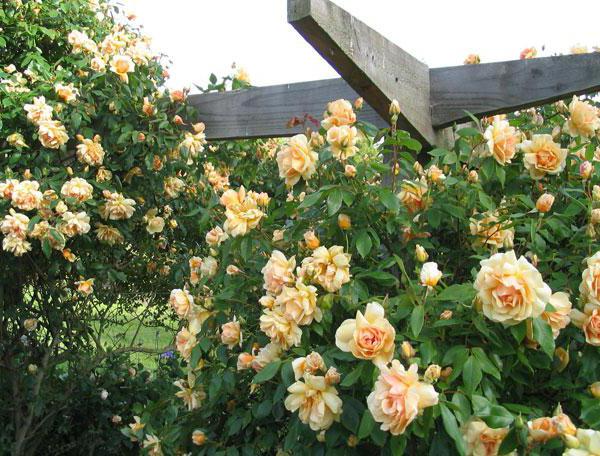

Basic description
The rose got its name because of the long trunk, on which shoots and branches are completely absent, but there is a crown in the form of a cap with many flowers and leaves. The elongated section of the trunk is called a stem.
The advantages of standard beauties are:
- The plant is highly resistant to cold and drought.
- They have a long flowering period compared to conventional varieties.
- Due to its height, the crown receives more sunlight.
- Due to the long trunk and lack of foliage near the ground, roses are less damaged by diseases and pests.
- Takes up little space in the flower bed.
The disadvantage is a kind of crown pruning to maintain this look. Here you will need certain skills and abilities.
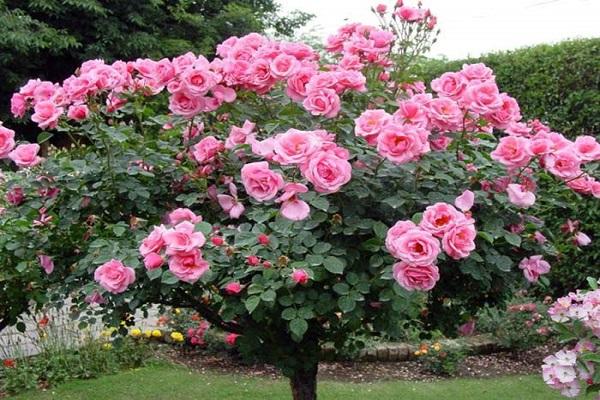

A tree-like rose is obtained by grafting an ordinary rose onto a wild rose. Therefore, the height of the resulting plant cannot exceed more than 1.5 meters. The main condition for the successful receipt of a standard beauty is the cultivation of a stock on a rosehip.
Such a rose has a slightly different structure than cultural ones. It has a root system, a long trunk (stem) and a crown. The branches of the crown can be erect (when the graft is from cultivated varieties) or flowing (when the graft is from a climbing rose).
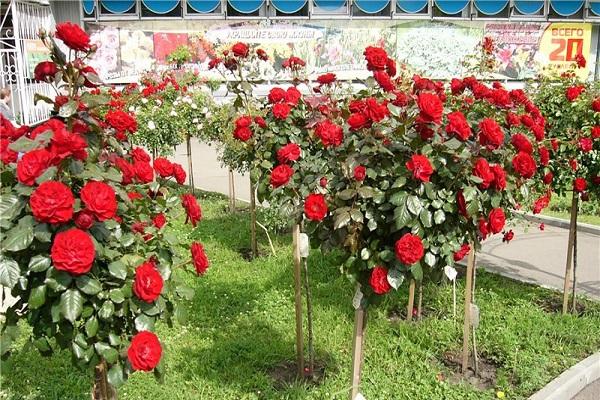

Gardeners reviews
Ann
I saw a super-dorothy on a trunk - this is SOMETHING, because the leaves are practically invisible, before that it blooms profusely.
viren
I have 4 stems. Lavaglut seemed to me not very suitable for a standard rose, the shoots are sticking up, the flowers are at the top. The rest - Rosarium Uetersen, The Fairy and Schuss I like.
Protection against diseases and pests
Standard rose can be affected by the following diseases:
- rust;
- purple and black spotting;
- gray rot of buds;
- powdery mildew;
- cercosporosis of leaves.
To overcome ailments, it is necessary to treat the trees with fungicide solutions. From pests on roses, spider mites, thrips, aphids can start, which can be defeated with the help of Actellik, Inta-Vira, Fitoverm and other insecticides for flower crops.
